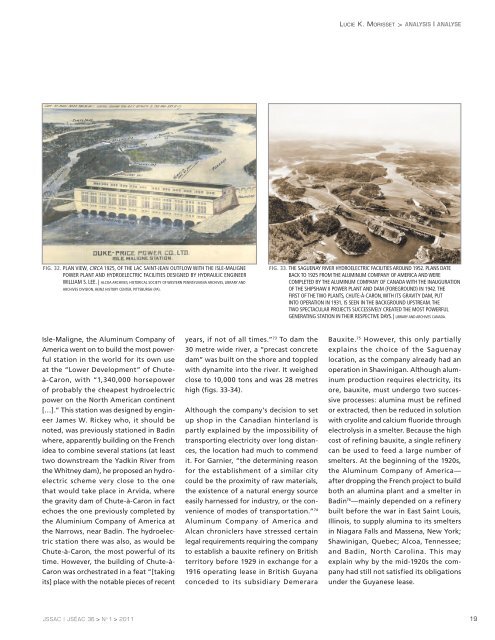'à es us e ct n s, es - Sexton Digtial Initiatives - Dalhousie University
'à es us e ct n s, es - Sexton Digtial Initiatives - Dalhousie University
'à es us e ct n s, es - Sexton Digtial Initiatives - Dalhousie University
Create successful ePaper yourself
Turn your PDF publications into a flip-book with our unique Google optimized e-Paper software.
fig. 32. PlAn view, circA 1925, Of the lAc sAint-JeAn OutflOw with the isle-mAligne<br />
POwer PlAnt And hydrOele<strong>ct</strong>ric fAciliti<strong>es</strong> d<strong>es</strong>igned by hydrAulic engineer<br />
williAm s. lee. | AlcOA Archiv<strong>es</strong>, histOricAl sOciety Of w<strong>es</strong>tern PennsylvAniA Archiv<strong>es</strong>, librAry And<br />
Archiv<strong>es</strong> divisiOn, heinz histOry center, Pittsburgh (PA).<br />
Isle-Maligne, the Aluminum Company of<br />
America went on to build the most powerful<br />
station in the world for its own <strong>us</strong>e<br />
at the “Lower Development” of Chuteà-Caron,<br />
with “1,340,000 horsepower<br />
of probably the cheap<strong>es</strong>t hydroele<strong>ct</strong>ric<br />
power on the North American continent<br />
[…].” This station was d<strong>es</strong>igned by engineer<br />
Jam<strong>es</strong> W. Rickey who, it should be<br />
noted, was previo<strong>us</strong>ly stationed in Badin<br />
where, apparently building on the French<br />
idea to combine several stations (at least<br />
two downstream the Yadkin River from<br />
the Whitney dam), he proposed an hydroele<strong>ct</strong>ric<br />
scheme very close to the one<br />
that would take place in Arvida, where<br />
the gravity dam of Chute-à-Caron in fa<strong>ct</strong><br />
echo<strong>es</strong> the one previo<strong>us</strong>ly completed by<br />
the Aluminium Company of America at<br />
the Narrows, near Badin. The hydroele<strong>ct</strong>ric<br />
station there was also, as would be<br />
Chute-à-Caron, the most powerful of its<br />
time. However, the building of Chute-à-<br />
Caron was orch<strong>es</strong>trated in a feat “[taking<br />
its] place with the notable piec<strong>es</strong> of recent<br />
JSSAC | JSÉAC 36 > N o 1 > 2011<br />
years, if not of all tim<strong>es</strong>.” 73 To dam the<br />
30 metre wide river, a “precast concrete<br />
dam” was built on the shore and toppled<br />
with dynamite into the river. It weighed<br />
close to 10,000 tons and was 28 metr<strong>es</strong><br />
high (figs. 33-34).<br />
Although the company’s decision to set<br />
up shop in the Canadian hinterland is<br />
partly explained by the impossibility of<br />
transporting ele<strong>ct</strong>ricity over long distanc<strong>es</strong>,<br />
the location had much to commend<br />
it. For Garnier, “the determining reason<br />
for the <strong>es</strong>tablishment of a similar city<br />
could be the proximity of raw materials,<br />
the existence of a natural energy source<br />
easily harn<strong>es</strong>sed for ind<strong>us</strong>try, or the convenience<br />
of mod<strong>es</strong> of transportation.” 74<br />
Aluminum Company of America and<br />
Alcan chroniclers have str<strong>es</strong>sed certain<br />
legal requirements requiring the company<br />
to <strong>es</strong>tablish a bauxite refinery on British<br />
territory before 1929 in exchange for a<br />
1916 operating lease in British Guyana<br />
conceded to its subsidiary Demerara<br />
Lucie K. Morisset > aNalysis | aNalyse<br />
fig. 33. the sAguenAy river hydrOele<strong>ct</strong>ric fAciliti<strong>es</strong> ArOund 1952. PlAns dAte<br />
bAck tO 1925 frOm the Aluminum cOmPAny Of AmericA And were<br />
cOmPleted by the Aluminum cOmPAny Of cAnAdA with the inAugurAtiOn<br />
Of the shiPshAw ii POwer PlAnt And dAm (fOregrOund) in 1942. the<br />
first Of the twO PlAnts, chute-à-cArOn, with its grAvity dAm, Put<br />
intO OPerAtiOn in 1931, is seen in the bAckgrOund uPstreAm. the<br />
twO sPe<strong>ct</strong>AculAr PrOJe<strong>ct</strong>s succ<strong>es</strong>sively creAted the mOst POwerful<br />
generAting stAtiOn in their r<strong>es</strong>Pe<strong>ct</strong>ive dAys. | librAry And Archiv<strong>es</strong> cAnAdA.<br />
Bauxite. 75 However, this only partially<br />
explains the choice of the Saguenay<br />
location, as the company already had an<br />
operation in Shawinigan. Although aluminum<br />
produ<strong>ct</strong>ion requir<strong>es</strong> ele<strong>ct</strong>ricity, its<br />
ore, bauxite, m<strong>us</strong>t undergo two succ<strong>es</strong>sive<br />
proc<strong>es</strong>s<strong>es</strong>: alumina m<strong>us</strong>t be refined<br />
or extra<strong>ct</strong>ed, then be reduced in solution<br />
with cryolite and calcium fluoride through<br />
ele<strong>ct</strong>rolysis in a smelter. Beca<strong>us</strong>e the high<br />
cost of refining bauxite, a single refinery<br />
can be <strong>us</strong>ed to feed a large number of<br />
smelters. At the beginning of the 1920s,<br />
the Aluminum Company of America—<br />
after dropping the French proje<strong>ct</strong> to build<br />
both an alumina plant and a smelter in<br />
Badin76 —mainly depended on a refinery<br />
built before the war in East Saint Louis,<br />
Illinois, to supply alumina to its smelters<br />
in Niagara Falls and Massena, New York;<br />
Shawinigan, Quebec; Alcoa, Tenn<strong>es</strong>see;<br />
and Badin, North Carolina. This may<br />
explain why by the mid-1920s the company<br />
had still not satisfied its obligations<br />
under the Guyan<strong>es</strong>e lease.<br />
19

















